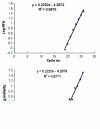Identifying and quantifying genotypes in polyclonal infections due to single species
- PMID: 16704787
- PMCID: PMC3291430
- DOI: 10.3201/eid1203.05057
Identifying and quantifying genotypes in polyclonal infections due to single species
Abstract
Simultaneous infection with multiple pathogens of the same species occurs with HIV, hepatitis C, Epstein-Barr virus, dengue, tuberculosis, and malaria. However, available methods do not distinguish among or quantify pathogen genotypes in individual patients; they also cannot test for novel insertions and deletions in genetically modified organisms. The strategy reported here accomplishes these goals with real-time polymerase chain reaction (PCR) and capillary electrophoresis. Real-time PCR with allotype-specific primers defines the allotypes (strains) present and the intensity of infection (copy number). Capillary electrophoresis defines the number of genotypes within each allotype and the intensity of infection by genotype. This strategy can be used to study the epidemiology of emerging infectious diseases with simultaneous infection by multiple genotypes, as demonstrated here with malaria. It also permits testing for insertions or deletions in genetically modified organisms that may be used for bioterrorism.
Figures




References
-
- Loroño-Pino MA, Cropp CB, Farfán JA, Vorndam AV, Rodríguez-Angulo EM, Rosado-Paredes EP, et al. Common occurrence of concurrent infections by multiple dengue virus serotypes. Am J Trop Med Hyg. 1999;61:725–30. - PubMed
Publication types
MeSH terms
Grants and funding
LinkOut - more resources
Full Text Sources
